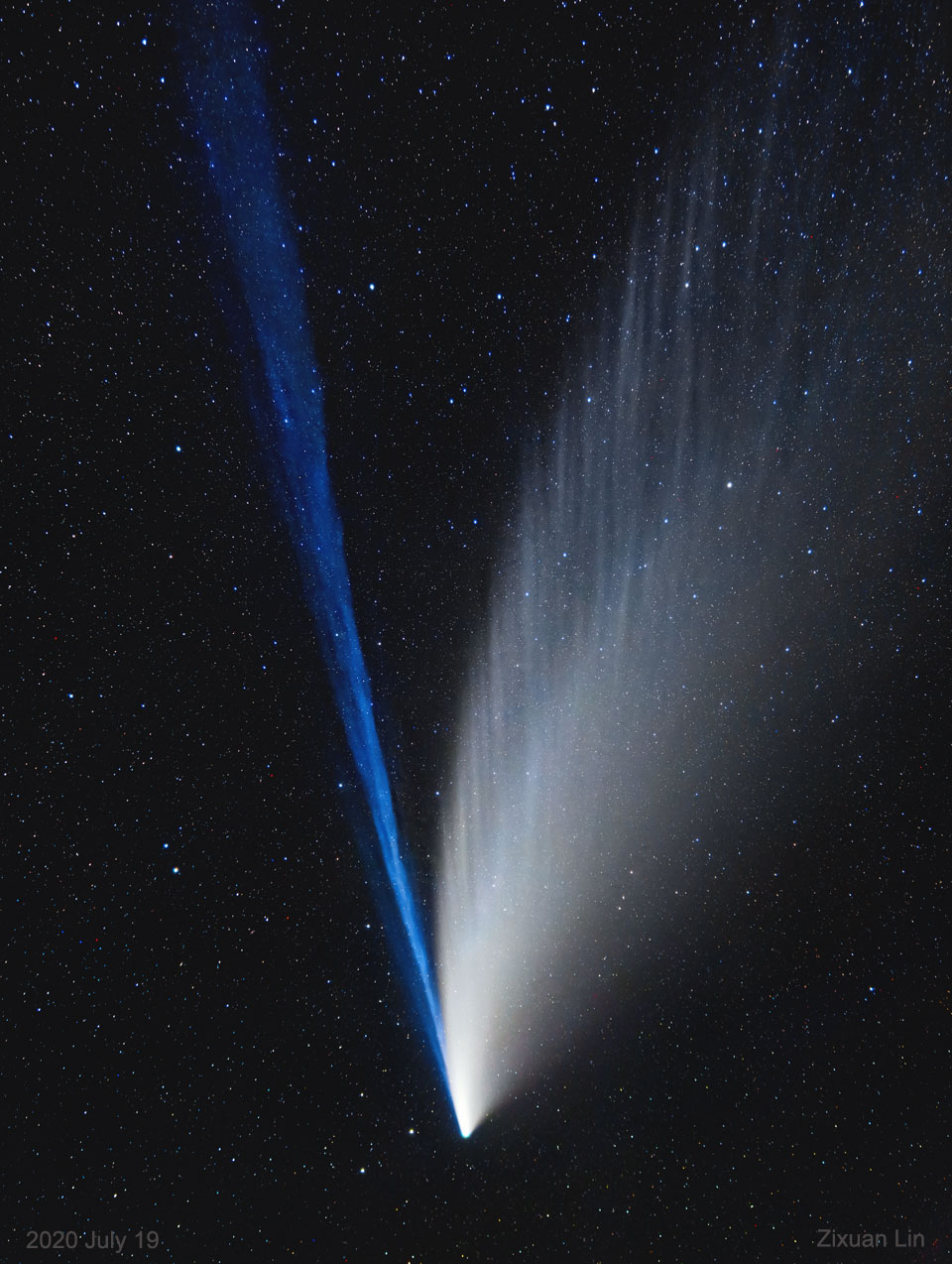Blog
https://www.youtube.com/watch?v=dx_5NeNBnv0
more...https://www.youtube.com/watch?v=7lNdSqrTltw
more...Approximately 85 million light-years from Earth, in the constellation of Libra, is the beautiful galaxy NGC 5861, captured here by the NASA/ESA Hubble Space Telescope.
NGC 5861 is an intermediate spiral galaxy. Astronomers classify most galaxies by their morphology. For example, the Milky Way galaxy is a barred spiral galaxy. An intermediate spiral galaxy has a shape lying in between that of a barred spiral galaxy, one that appears to have a central bar-shaped structure, and that of an unbarred spiral galaxy, one without a central bar.
Two supernovae, SN1971D and SN2017erp, have been observed in the galaxy. Supernovae are powerful and luminous explosions that can light up the night sky. The brightest supernova ever recorded was possibly SN 1006. It shone 16 times as bright as Venus from April 30 to May 1, 1006 AD.

Bobby Matos (born July 24, 1941 in the Bronx, New York – November 11, 2017 Los Angeles ) was a Latin jazz percussionist.
He began playing music by hitting pots and pans in his grandmother’s apartment. As a youth, he studied with conga drum masters Patato Valdez and Mongo Santamaría. While playing all over New York, he was encouraged to play timbales by Willie Bobo and Tito Puente and in the late 60s attended The New School and the Manhattan School of Music. Around this time, he recorded “My Latin Soul” for Phillips International Records, which made his reputation as a bandleader.
Matos has toured and recorded with artists Ben Vereen, Bette Midler, Fred Neil, Jim Croce, Joe Loco, Ray Rivera, Miriam Makeba, and scores of others. He has an extensive discography and 5 critically acclaimed albums with Ubiquity Records. His latest record is “Gratitude” on Dawan Muhammadd’s LifeForce jazz label.
more...Charles McPherson (born July 24, 1939) is an American jazz alto saxophonist born in Joplin, Missouri, and raised in Detroit, Michigan, who worked intermittently with Charles Mingus from 1960 to 1974, and as a performer leading his own groups.
McPherson also was commissioned to help record ensemble renditions of pieces from Charlie Parker on the 1988 soundtrack for the film Bird.
more...Ahmad Alaadeen (July 24, 1934 – August 15, 2010) was a jazz saxophonist and educator whose career spanned over six decades. A longtime fixture on the Kansas City jazz scene, Aladeen came to wider prominence in the 1990s with a series of self-released albums featuring his swing– and hard bop-oriented compositions that led Allmusic critic Scott Yanow to declare that the saxophonist “deserves to be much better known.
more...Billy Taylor (July 24, 1921 – December 28, 2010) was an American jazz pianist, composer, broadcaster and educator. He was the Robert L. Jones Distinguished Professor of Music at East Carolina University in Greenville, and from 1994 was the artistic director for jazz at the John F. Kennedy Center for the Performing Arts in Washington, D.C.
A jazz activist, Taylor sat on the Honorary Founders Board of The Jazz Foundation of America, an organisation he started in 1989, with Ann Ruckert, Herb Storfer and Phoebe Jacobs, to save the homes and the lives of America’s elderly jazz and blues musicians, later including musicians who survived Hurricane Katrina.
Taylor was also a jazz educator, who lectured in colleges, served on panels and travelled worldwide as a jazz ambassador. Critic Leonard Featheronce said, “It is almost indisputable that Dr. Billy Taylor is the world’s foremost spokesman for jazz.”
Taylor was born in Greenville, North Carolina, but moved to Washington, D.C., when he was five years old. He grew up in a musical family and learned to play different instruments as a child, including guitar, drums and saxophone. He was most successful at the piano, and had classical piano lessons with Henry Grant, who had educated Duke Ellington a generation earlier. Taylor made his first professional appearance playing keyboard at the age of 13 and was paid one dollar.
https://www.youtube.com/watch?v=mdG9JSdlE-k
more...Malagueñas derive from local variety of the Fandangos, a type of dance that, with different regional variations and even different names, became very popular in great part of Spain in the 18th century. Although nowadays malagueñas are a typical instance of “cante libre”, performed at libitum and normally not used for the dance, folkloric fandangos were originally sung and played at a fast speed, with a rhythmic pattern in 6
8, to accompany dance. Some of these primitive fandangos from Málaga, called Verdiales are still performed nowadays at folkloric gatherings by large non-professional groups called “Pandas”, which use a high number of guitars, “bandurrias” (a sort of mandoline), violins, and tambourines.
more...
https://www.youtube.com/watch?v=gFgHlDimqSw
more...NGC 1398 is an isolated barred spiral galaxy exhibiting a double ring structure. It is located 65 million light years from the Earth, in the constellation of Fornax. The galaxy, with a diameter of 135,000 light years, is slightly larger than the Milky Way. Over 100 billion stars are in the galaxy. It was first discovered by Friedrich Winnecke of Karlsruhe, Germany, on 17 December 1868, while he was searching for comets.

Lakshminarayana Subramaniam (born 23 July 1947) is an Indian violinist, composer and conductor, trained in the classical Carnatic music tradition and Western classical music, and renowned for his virtuoso playing techniques and compositions in orchestral fusion.
Subramaniam was born to V. Lakshminarayana Iyer and Seethalakshmi, both accomplished musicians.
He lived in Jaffna during his younger years, taking up music studies before the age of five. He began training in violin under the tutelage of his father, Professor V. Lakshminarayana. “Mani”, as he is fondly known by fellow musicians and his family, gave his first public performance at the age of six.
His uncles include Ramnad Raghavan and Ramnad Krishnan. His brothers are also acclaimed musicians, and include the violinist-composers L. Shankar (alias. Shenkar), and the late L. Vaidyanathan. He has released recordings with both.
Subramaniam developed a passion for music as well as science from a young age, studying Medicine and acquiring his M.B.B.S. at Madras Medical College. He registered as a General Practitioner, before deciding to pursue music full-time. He has a Master’s degree in Western classical music, which he acquired at the California Institute of the Arts.
more...Steve Lacy (July 23, 1934 – June 4, 2004), born Steven Norman Lackritz in New York City, was an American jazz saxophonist and composer recognized as one of the important players of soprano saxophone. Coming to prominence in the 1950s as a progressive dixieland musician, Lacy went on to a long and prolific career. He worked extensively in experimental jazz and to a lesser extent in free improvisation, but Lacy’s music was typically melodic and tightly-structured. Lacy also became a highly distinctive composer, with compositions often built out of little more than a single questioning phrase, repeated several times.
The music of Thelonious Monk became a permanent part of Lacy’s repertoire after a stint in the pianist’s band, with Monk’s songs appearing on virtually every Lacy album and concert program; Lacy often partnered with trombonist Roswell Rudd in exploring Monk’s work. Beyond Monk, Lacy performed the work of jazz composers such as Charles Mingus, Duke Ellington and Herbie Nichols; unlike many jazz musicians he rarely played standard popular or show tunes.
Lacy began his career at sixteen playing Dixieland music with much older musicians such as Henry “Red” Allen, Pee Wee Russell, George “Pops” Foster and Zutty Singleton and then with Kansas City jazz players like Buck Clayton, Dicky Wells, and Jimmy Rushing. He then became involved with the avant-garde, performing on Jazz Advance (1956), the debut album of Cecil Taylor,[2]:55 and appearing with Taylor’s groundbreaking quartet at the 1957 Newport Jazz Festival; he also made a notable appearance on an early Gil Evans album. His most enduring relationship, however, was with the music of Thelonious Monk: he recorded the first album to feature only Monk compositions (Reflections, Prestige, 1958) and briefly played in Monk’s band in 1960 and later on Monk’s Big Band and Quartet in Concert album (Columbia, 1963).
more...Amália da Piedade Rebordão Rodrigues GCSE, GCIH (1 July 1920 – 6 October 1999), better known as Amália Rodrigues (Portuguese pronunciation: [ɐˈmaliɐ ʁuˈðɾiɣɨʃ]) or popularly as Amália, was a Portuguese fadista (fado singer) and actress.
Known as the ‘Rainha do Fado’ (“Queen of Fado”), Rodrigues was instrumental in popularising fado worldwide and travelled internationally throughout her career. Amália remains the best-selling Portuguese artist in history.
more...William Thomas “Champion Jack” Dupree (July 23, 1909 or July 4, 1910 – January 21, 1992) was an American blues and boogie-woogie pianist and singer. His nickname was derived from his early career as a boxer.
Dupree was a New Orleans blues and boogie-woogie pianist, a barrelhouse “professor”. His father was from the Belgian Congo and his mother was part African American and Cherokee. His birth date has been given as July 4, July 10, and July 23, 1908, 1909, or 1910; the researchers Bob Eagle and Eric LeBlanc give July 4, 1910.
He was orphaned at the age of eight and was sent to the Colored Waifs Home in New Orleans, an institution for orphaned or delinquent boys (about the same time, Louis Armstrong was also sent there as a child, after being arrested as a “dangerous and suspicious character”). Dupree taught himself to play the piano there and later apprenticed with Tuts Washington and Willie Hall, whom he called his father and from whom he learned “Junker’s Blues“. He was also a “spy boy” for the Yellow Pocahontas tribe of the Mardi Gras Indians. He soon began playing in barrelhouses and other drinking establishments.
He began a life of travelling, living in Chicago, where he worked with Georgia Tom, and in Indianapolis, Indiana, where he met Scrapper Blackwell and Leroy Carr. He also worked as a cook. In Detroit, after Joe Louis encouraged him to become a boxer, he fought 107 bouts, winning Golden Gloves and other championships and picking up the nickname Champion Jack, which he used the rest of his life. He returned to Chicago at the age of 30 and joined a circle of recording artists, including Big Bill Broonzy and Tampa Red, who introduced him to the record producer Lester Melrose. Many of Dupree’s songs were later credited to Melrose as composer, and Melrose claimed publishing rights to them.
more...Of the two tails evident, the blue ion tail on the left points directly away from the Sun and is pushed out by the flowing and charged solar wind. Structure in the ion tail comes from different rates of expelled blue-glowing ions from the comet’s nucleus, as well as the always complex and continually changing structure of our Sun’s wind. Most unusual for Comet C/2020 F3 (NEOWISE), though, is the wavy structure of its dust tail. This dust tail is pushed out by sunlight, but curves as heavier dust particles are better able to resist this light pressure and continue along a solar orbit. Comet NEOWISE‘s impressive dust-tail striations are not fully understood, as yet, but likely related to rotating streams of sun-reflecting grit liberated by ice melting on its 5-kilometer wide nucleus. The featured 40-image conglomerate, digitally enhanced, was captured three days ago through the dark skies of the Gobi Desert in Inner Mongolia, China. Comet NEOWISE will make it closest pass to the Earth tomorrow as it moves out from the Sun. The comet, already fading but still visible to the unaided eye, should fade more rapidly as it recedes from the Earth.

More Posts
- Gary Burton
- Curtis Counce
- Django Reinhardt
- World Music Rémi Geffroy
- Daily Roots Tommy McCook
- Garth Hudson Memorial
- Mardi Gras Day 2025
- Zimbabwean Proverb
- Cosmo NGC 7000
- Hammie Nixon
- Blind Willie Johnson
- Eberhard Weber
- Sam Cooke
- J.J. Johnson
- World Music La Pambelé
- Daily Roots The Aggrovators
- Echos of Freedom by Dr Martin Luther King Jr
- Cosmo NGC 2244
- Richie Havens
- Snooks Eaglin